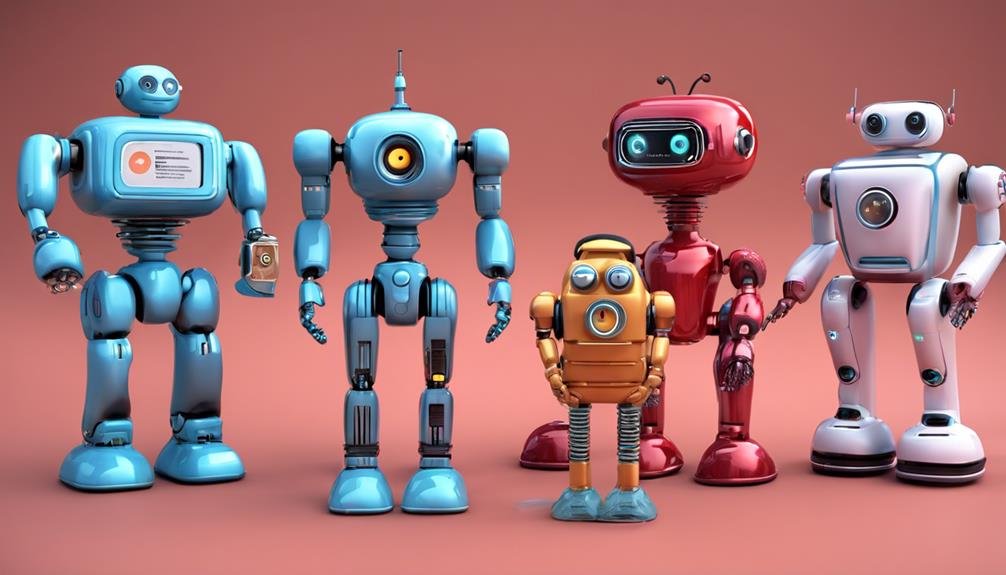Chatbot Definition, Types, Pros & Cons, Examples
Innovative chatbots are computer programs mimicking human conversations, integrating Conversational AI for personalized responses. They are versatile tools utilized in customer service, sales, and marketing, operating 24/7 for cost-effective support. With AI and natural language processing, they guarantee effective interactions, offering enhanced user experiences. Despite providing round-the-clock service and leveraging technology for better understanding, there are ethical concerns and limitations to take into account. Real-world applications include retail assistance, weather updates, financial inquiries, and health information dissemination. The impact of chatbots extends to resolving queries promptly, improving customer satisfaction, and promising future advancements. These insights showcase the vast potential of chatbot technology.
Key Takeaways
- Chatbot is a conversational AI program for customer support and marketing.
- Types include set guidelines and machine learning chatbots for varied applications.
- Pros include 24/7 service, AI integration, and cost-effective customer support.
- Cons involve data privacy concerns, limitations in personalization, and maintenance costs.
- Examples range from retail assistance to health information dissemination, showcasing diverse applications.
What Is a Chatbot?
In the domain of modern technology, a chatbot is a sophisticated computer program designed to simulate human conversation either through voice commands or text chats. This advanced application of chatbot technology integrates Conversational AI to engage users in meaningful interactions, providing efficient and personalized responses.
Businesses leverage chatbots for customer support, sales, and marketing, enhancing customer experiences and operational efficiency. With the ability to operate 24/7, chatbots offer a cost-effective solution for companies seeking continuous customer service availability.
The utilization of AI and natural language processing enables chatbots to understand and respond to customer queries effectively, contributing to improved customer satisfaction and data collection for businesses.
Different Types of Chatbots
Have you ever wondered about the diverse classifications of chatbots based on their functionalities and capabilities in the domain of artificial intelligence technology? Chatbots come in various types, each serving different purposes.
From set guidelines chatbots that have a limited conversation scope to machine learning chatbots that self-learn from interactions, the customization and future trends in chatbots are evolving rapidly.
Enhancing chatbot user experience is a key focus for businesses, but they also face implementation challenges such as ensuring seamless integration with existing systems and overcoming user skepticism.
As technology advances, chatbots are expected to become more intuitive, predictive, and efficient, reshaping how businesses interact with customers and optimizing operations.
Pros and Cons of Chatbots
Delving deeper into the world of chatbots reveals a dual perspective encompassing the advantages and disadvantages inherent in their integration within business frameworks. On the significant side, chatbots provide 24/7 customer service, leading to reduced costs and improved efficiency by freeing up phone lines. They leverage AI and natural language processing to enhance understanding of customer needs, while also enabling data collection for companies.
However, ethical considerations arise regarding data privacy and security. User experience is vital, as limitations such as potential misunderstandings of queries and lack of personalization can impact customer satisfaction. Additionally, customization and maintenance costs can be significant factors to take into account when implementing chatbots in business operations.
Real-world Chatbot Examples
Curious to explore real-world applications of chatbots in action?
Chatbots have found extensive use across various industries, enhancing user experience and streamlining processes. In the retail sector, chatbots assist with customer queries, purchases, and order tracking, providing immediate support.
Weather forecasting services utilize chatbots to deliver real-time weather updates and personalized alerts efficiently. Financial institutions employ chatbots for services like account inquiries and transaction assistance, improving customer interactions.
Additionally, chatbots have been instrumental in public policy, with health chatbots aiding in disseminating crucial information during the COVID-19 pandemic.
These real-world examples showcase the versatility and benefits of chatbots in enhancing industry applications and optimizing user experience.
Impact of Chatbots
The integration of chatbots across industries has greatly impacted customer service, operational efficiency, and user engagement. AI advancements have enabled chatbots to provide seamless interactions, resolving customer queries promptly and accurately.
Businesses benefit from cost savings and improved customer satisfaction as chatbots operate 24/7, catering to user needs efficiently. The future applications of chatbots are promising, with advancements in AI technology enhancing their capabilities to handle more complex tasks.
From personalized recommendations to streamlined processes, chatbots are set to revolutionize various sectors by offering tailored solutions and gathering valuable data insights. Embracing chatbot technology guarantees businesses stay competitive and agile in meeting evolving customer expectations.
Conclusion
To sum up, chatbots have revolutionized customer interactions in various sectors, offering benefits like 24/7 availability and data collection capabilities.
While some may argue that chatbots lack the personal touch of human interaction, their efficiency and cost-effectiveness cannot be denied.
As businesses continue to leverage chatbot technology for improving customer service and streamlining operations, it is important to understand their evolving role in shaping user experiences and driving innovation in the digital age.







